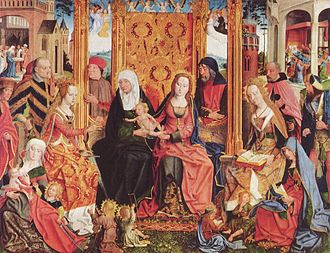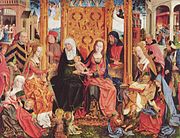
According to Christian apocryphal and Islamic tradition, Saint Anne was the mother of Mary and the maternal grandmother of Jesus. Mary's mother is not named in the canonical gospels. In writing, Anne's name and that of her husband Joachim come only from New Testament apocrypha, of which the Gospel of James seems to be the earliest that mentions them. The mother of Mary is mentioned but not named in the Quran.
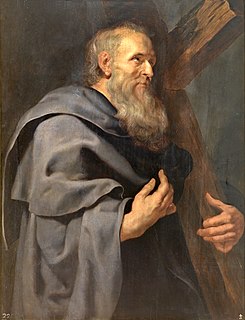
Philip the Apostle was one of the Twelve Apostles of Jesus according to the New Testament. Later Christian traditions describe Philip as the apostle who preached in Greece, Syria, and Phrygia.

James the Less is a figure of early Christianity, one of the Twelve chosen by Jesus. He is also called "the Minor", "the Little", "the Lesser", or "the Younger", according to translation. He is not to be confused with James the Great. He is identified by some as James, son of Alphaeus and as James, brother of Jesus, thought of by Jerome and those who followed him as really the cousin of Jesus. James the Less was traditionally commemorated with St. Philip either on May 1 or May 3 in the Western Christian calendars.

James the Just, or a variation of James, brother of the Lord, was "a brother of Jesus", according to the New Testament. He was an early leader of the Jerusalem Church of the Apostolic Age. Traditionally, it is believed he was martyred in AD 62 or 69 by being stoned to death by the Pharisees on order of High Priest Ananus ben Ananus.
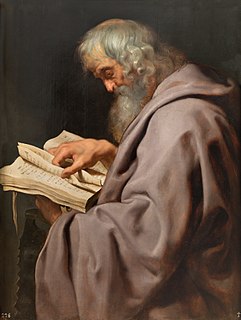
Simon the Zealot or Simon the Canaanite or Simon the Canaanean was one of the most obscure among the apostles of Jesus. A few pseudepigraphical writings were connected to him, but Saint Jerome does not include him in De viris illustribus written between 392 and 393 AD.

Cleopas, also spelled Cleophas, was a figure of early Christianity, one of the two disciples who encountered Jesus during the Road to Emmaus appearance in Luke 24:13–32.

In the New Testament, Salome was a follower of Jesus who appears briefly in the canonical gospels and in apocryphal writings. She is named by Mark as present at the crucifixion and as one of the women who found Jesus's tomb empty. Interpretation has further identified her with other women who are mentioned but not named in the canonical gospels. In particular, she is often identified as the wife of Zebedee, the mother of James and John, two of the Twelve apostles. In medieval tradition Salome was counted as one of the Three Marys who were daughters of Saint Anne, so making her the sister or half-sister of Mary, mother of Jesus.

Jude was one of the Twelve Apostles of Jesus according to the New Testament. He is generally identified with Thaddeus, and is also variously called Jude of James, Jude Thaddaeus, Judas Thaddaeus or Lebbaeus. He is sometimes identified with Jude, the brother of Jesus, but is clearly distinguished from Judas Iscariot, the apostle who betrayed Jesus prior to his crucifixion. Catholic writer Michal Hunt suggests that Judas Thaddaeus became known as Jude after early translators of the New Testament from Greek into English sought to distinguish him from Judas Iscariot and subsequently abbreviated his forename. Most versions of the New Testament in languages other than English and French refer to Judas and Jude by the same name.
Clopas is a figure of early Christianity. The name appears in the New Testament, specifically in John 19:25:
Near the cross of Jesus stood his mother, his mother's sister, Mary the wife of Clopas, and Mary Magdalene.

According to the Gospel of John, Mary of Clopas was one of the women present at the crucifixion of Jesus and bringing supplies for his funeral. The expression Mary of Clopas in the Greek text is ambiguous as to whether Mary was the daughter or wife of Clopas, but exegesis has commonly favoured the reading "wife of Clopas". Hegesippus identified Clopas as a brother of Saint Joseph. In the Roman Martyrology she is remembered with Saint Salome on April 24.

The Holy Family consists of the Child Jesus, the Virgin Mary and Saint Joseph. The subject became popular in art from the 1490s on, but veneration of the Holy Family was formally begun in the 17th century by Saint François de Laval, the first bishop of New France, who founded a confraternity.

Jude is one of the brothers of Jesus (Greek: ἀδελφοί, romanized: adelphoi, lit. 'brethren') according to the New Testament. He is traditionally identified as the author of the Epistle of Jude, a short epistle which is reckoned among the seven general epistles of the New Testament—placed after Paul's epistles and before the Book of Revelation—and considered canonical by Christians. Catholics and Eastern Orthodox Christians believe this Jude is the same person as Jude the Apostle and that Jude was perhaps a cousin, but not literally a brother of Jesus, or perhaps St. Joseph’s son from a previous marriage.
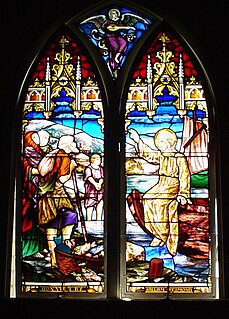
Matthew 10:3 is the third verse in the ninth chapter of the Gospel of Matthew in the New Testament.

James, son of Alphaeus was one of the Twelve Apostles of Jesus, appearing under this name in all three of the Synoptic Gospels' lists of the apostles. He is often identified with James the Less and commonly known by that name in church tradition. He is also labelled "the minor", "the little", "the lesser", or "the younger", according to translation. He is distinct from James, son of Zebedee and in some interpretations also from James, brother of Jesus. He appears only four times in the New Testament, each time in a list of the twelve apostles.

Joachim was, according to Christian tradition, the husband of Saint Anne and the father of Mary, the mother of Jesus. The story of Joachim and Anne first appears in the apocryphal Gospel of James. His feast day is 26 July, a date shared with Saint Anne.

The Virgin and Child with Saint Anne or Madonna and Child with Saint Anne is a subject in Christian art showing Saint Anne with her daughter, the Virgin Mary, and her grandson Jesus. This depiction has been popular in Germany and neighboring countries since the 14th century.
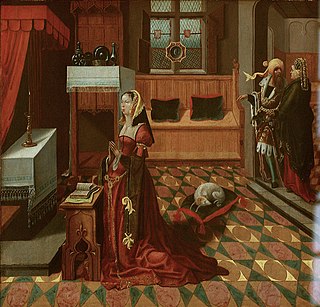
Emerentia is the name given for a grandmother of Mary, mother of Jesus, in some European traditions and art from the late 15th century. She is not to be confused with Saint Emerentiana, a Roman martyr of the 3rd century.
The presence of a group of female disciples of Jesus at the crucifixion of Jesus is found in all four Gospels of the New Testament. There have been different interpretations how many and which women were present. Although some Christian traditions hold that there were Three Marys at the cross, only one gospel claims this, and these names differ from the other gospels.

The Holy Kinship is a circa 1495 oil on panel painting of Holy Kinship by the workshop of the renaissance artist Geertgen tot Sint Jans in the collection of the Rijksmuseum.

The name James appears 38 times in the New Testament. James was a very common given name in the historical period and region of Jesus, but surnames were still very rare. It is therefore not always clear which person these names refer to, and whether some refer to the same person or distinct characters, which has led to confusion. Therefore, Christian authors and modern scholars have given these men names based on their known attributes. According to American theologian and scholar Donald Hagner (2012), there are at least 5, and possibly up to 7, different Jameses in the New Testament.

